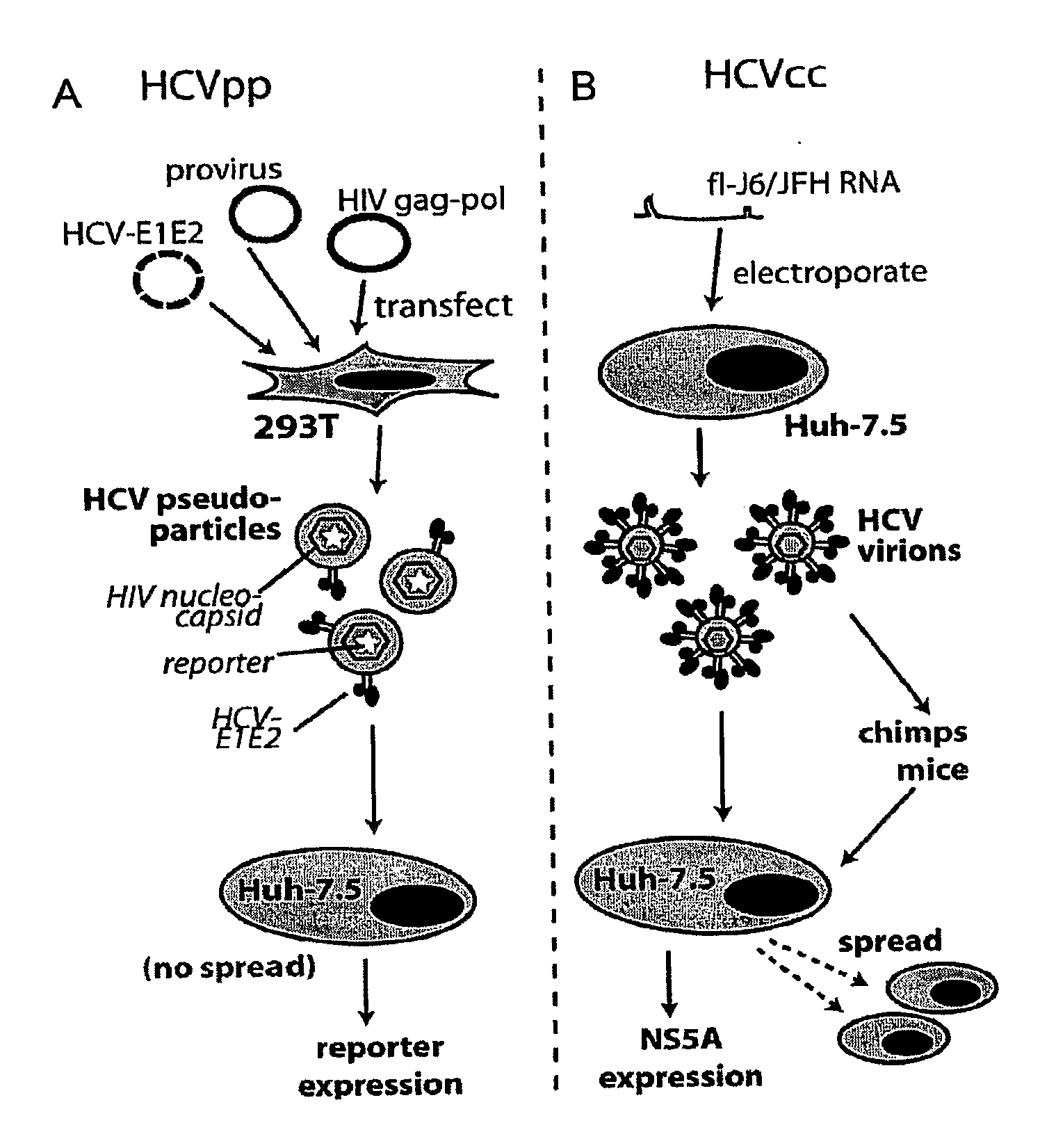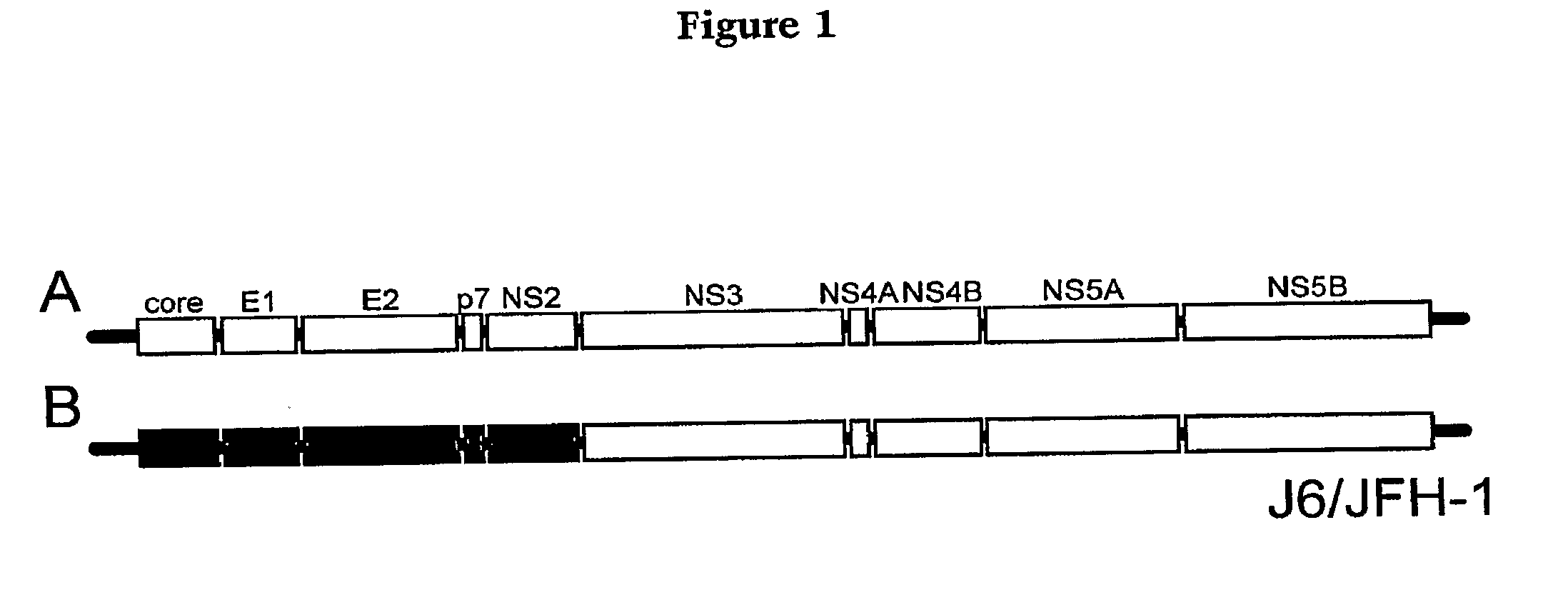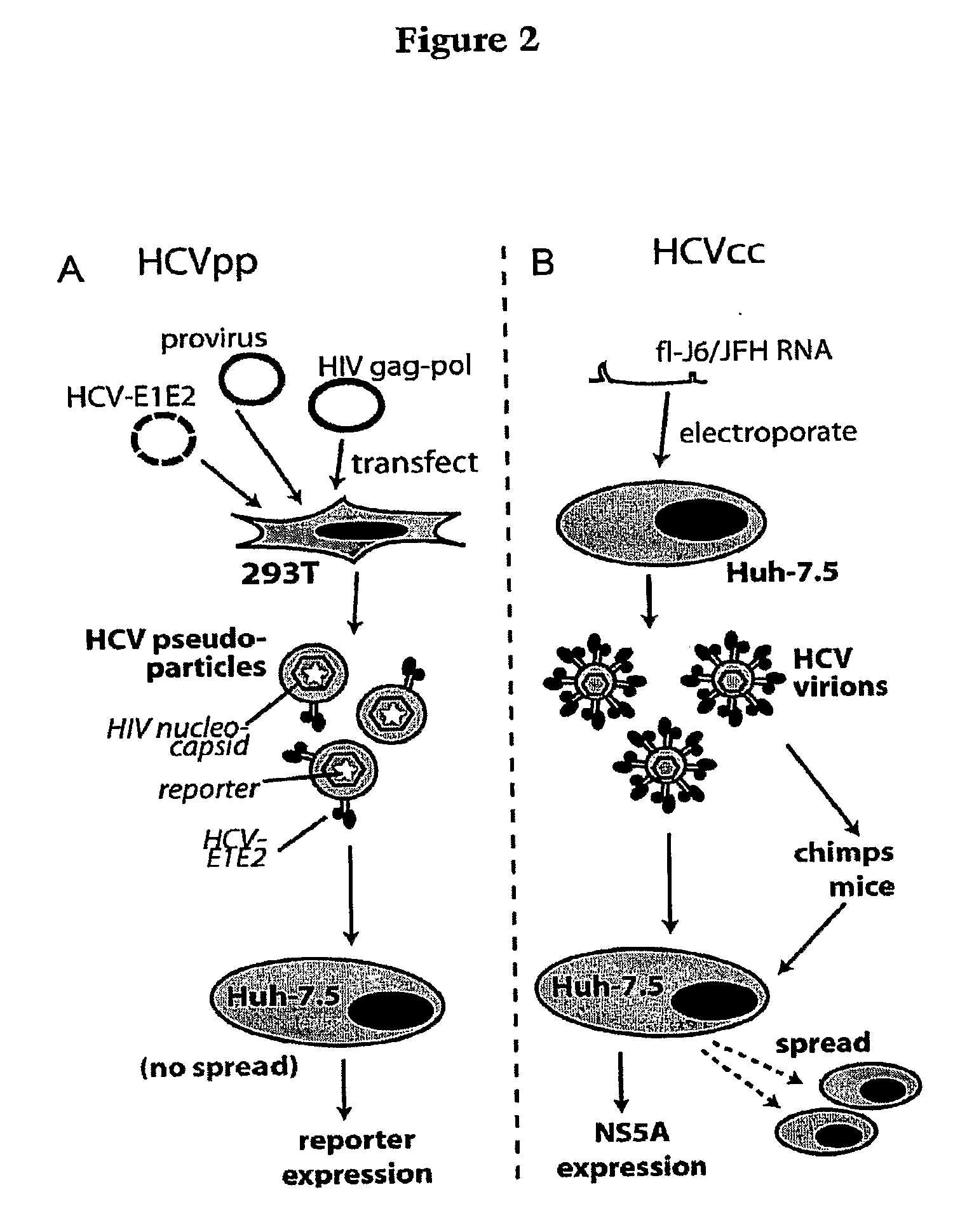[0031]A variety of methods can be used to determine if the compound or agent prevents or mitigates interaction of a region of a Hepatitis C Virus with a region of a Claudin-1 protein. In one embodiment of the method, inhibition of binding or interaction of the recombinant protein of step (a) is determined in step (c) by assaying for retention of the recombinant protein by a HCV envelope protein, by a cell expressing HCV envelope proteins E1 and E2, by a HCV pseudotyped retroviral particle, by a HCV cell culture particle, by an ex vivo HCV cell culture particle, or by an HCV provided in step (b), wherein decreased retention of the recombinant protein is indicative of binding inhibition. In other embodiments of the method, in particular those involving use of cells or virus particles, determination of interaction or fusion in step (c) is effected by assaying a reporter protein. This reporter protein can be selected from the group consisting of a fluorescent protein, an immunologically detectable protein or an enzyme.
[0032]Fluorescent proteins can be selected from the group consisting of a red fluorescent protein, a green fluorescent protein, or a yellow fluorescent protein. Reporter enzymes can be selected from the group consisting of a chloramphenicol acetyl transferase, a beta galactosidase, a beta glucuronidase, and an alkaline phosphatase. Other embodiments where a selectable maker gene is used are also contemplated. This selectable marker gene can be suitable for either dominant or negative selections. Selectable marker genes include, but are not limited to, zeocin resistance, neomycin, G418, DHFR, TK, or hygromycin resistance genes.
[0033]Compounds that prevent or mitigate interaction of a region of HCV with Claudin-1 are also provided. Compounds that prevent or mitigate interaction of a region of a Hepatitis C Virus with extracellular loop 1 of a Claudin-1 protein, wherein said compound is identified by the methods of the invention, are provided by this invention. Agents that prevent or mitigate interaction of a region of a Hepatitis C Virus with extracellular loop 1 of a Claudin-1 protein are also provided by this invention. These agents can be identified by the methods of the invention. The identified agent can be an antibody, an aptamer, a peptide, a peptidomimetic compound, or a recombinant protein. When the agent is antibody, it can be a synthetic antibody. The antibody can be a monoclonal or a single chain antibody. Other agents of the invention are peptide or peptidomimetic compounds comprising amino acid residues 28 to 49 of a Claudin-1 protein as shown in SEQ ID NO:1, conservative amino acid substitutions thereof, or a chemically derivatized variant thereof, wherein residue 32 is isoleucine and residue 48 is glutamic acid. The peptide or peptidomimetic compound agents can comprise any one or all of a residue 41 isoleucine, a residue 31 isoleucine, and a residue 33 serine of a Claudin-1 peptide sequence as shown in SEQ ID NO:1.
[0034]This invention also provides kits for identifying a compound or agent that prevents or mitigates interaction of a region of a Hepatitis C Virus with a region of a Claudin-1 protein. The kits comprise either i) a recombinant protein comprising at least amino acid residues 28 to 49 of a Claudin-1 protein as shown in SEQ ID NO:1 or conservative amino acid substitutions thereof; or ii) a recombinant vector that provides for expression of a membrane bound protein comprising at least amino acid residues 28 to 49 of a Claudin-1 protein as shown in SEQ ID NO:1 or conservative amino acid substitutions thereof, wherein said amino acid residues of said Claudin-1 protein are located extracellularly to a cell expressing said membrane bound protein, or a cell comprising said recombinant vector and instructions for using the kit to identify a compound or agent that prevents or mitigates interaction of a region of a Hepatitis C Virus with a region of a Claudin-1 protein. The kits can further comprise an HCV envelope protein, a recombinant vector encoding HCV envelope proteins E1 and E2, a recombinant vector encoding an HCV pseudotyped retroviral particle, a recombinant vector encoding an HCV cell culture particle, or a recombinant vector encoding an infectious HCV particle. Alternatively, the kit can contain a recombinant protein, a membrane bound protein provided by a vector or a membrane bound protein of a cell that comprises amino acid residues 28 to 81 or amino acid residues 1 to 102 of a Claudin 1 protein as shown in SEQ ID NO:1 or conservative amino acid substitutions thereof. In other embodiments, the kit can contain a recombinant protein, a membrane bound protein provided by a vector or a membrane bound protein of a cell that comprises a Claudin 1 protein or a Claudin 1 protein as shown in SEQ ID NO:1.
[0035]The invention further provides cell culture compositions that are useful for identifying compounds or agents that prevents or mitigates interaction of a region of a Hepatitis C Virus with a region of a Claudin-1 protein. Cell culture compositions of the invention comprise: i) a cell comprising a recombinant vector that provides for expression of a membrane bound protein comprising at least amino acid residues 28 to 49 of a Claudin-1 protein as shown in SEQ ID NO:1 or conservative amino acid substitutions thereof, wherein said amino acid residues of said Claudin-1 protein are located extracellularly to said cell, and either ii) a cell comprising a recombinant vector that encodes HCV envelope proteins E1 and E2 or iii) any one of an HCV pseudotyped retroviral particle, an HCV cell culture particle, an ex vivo HCV cell culture particle, or an HCV particle. In other embodiments of the invention, the recombinant vector of (i) provides for expression of a membrane bound protein comprising at least amino acids 28 to 81 or at least amino acids 1 to 102 of a Claudin-1 protein as shown in SEQ ID NO:1 or conservative amino acid substitutions thereof. Alternatively, the recombinant vector of (i) can provide for expression of a membrane bound protein comprising a Claudin-1 protein or for expression of a Claudin-1 protein as shown in SEQ NO:1 or conservative amino acid substitutions thereof. In the cell culture composition, the HCV pseudotyped retroviral vector can comprise an HCV E1 protein, an HCV E2 protein and a packaging competent retroviral genome containing a reporter gene. The packaging competent retroviral genome can be an HIV or an MLV packaging competent retroviral genome. Alternatively, the packaging competent retroviral genome is an envelope deficient retroviral genome. The recombinant vector of the cell culture composition can comprise at least one sequence encoding a transmembrane domain that is operably linked to a sequence encoding at least amino acid residues 28 to 49 of a Claudin-1 protein as shown in SEQ ID NO:1 or conservative amino acid substitutions thereof. In still other embodiments, the recombinant vector comprises a first sequence encoding a signal peptide, wherein said sequence is operably linked to a sequence encoding at least amino acid residues 28 to 49 the amino acid residues of the Claudin-1 protein or conservative amino acid substitutions thereof. Recombinant vectors that comprise a sequence encoding a signal peptide can further comprise a second sequence encoding a domain that binds to a membrane bound protein, wherein this second sequence is operably linked to the first sequence encoding the signal peptide and to a sequence encoding at least amino acid residues 28 to 49 of a Claudin-1 protein as shown in SEQ ID NO:1 or conservative amino acid substitutions thereof. Recombinant vectors that comprise a sequence encoding a signal peptide can further comprise a second sequence encoding a domain that provides for binding to a membrane, wherein this second sequence is operably linked to the first sequence encoding the signal peptide and to a sequence encoding at least amino acid residues 28 to 49 of a Claudin-1 protein as shown in SEQ ID NO:1 or conservative amino acid substitutions thereof.
[0036]The invention further provides for compositions that are useful for preventing entry of HCV into cells in a subject or in vitro. The composition of the invention comprises a non-naturally occurring agent or compound and a Claudin-1 protein, wherein the non-naturally occurring agent or compound is bound to extracellular loop 1 of said Claudin 1 protein and inhibits HCV entry. The composition can be obtained by administering the non-naturally occurring agent or compound to a subject selected from the group consisting of a mouse, a rat, a monkey, and a human. Alternatively, the composition can be obtained by contacting a cell comprising a recombinant vector that provides for expression of a membrane bound protein comprising at least amino acid residues 28 to 49 of a Claudin-1 protein as shown in SEQ ID NO:1 or conservative amino acid substitutions thereof, wherein the amino acid residues of said Claudin-1 protein are located extracellularly to a cell expressing said membrane bound protein, with the non-naturally occurring agent or compound. In still other embodiments, the composition is obtained by contacting a recombinant protein comprising at least amino acid residues 28 to 49 of a Claudin-1 protein as shown in SEQ ID NO:1 with the non-naturally occurring agent or compound. The non-naturally occurring agent can be an antibody, an aptamer, or a recombinant protein. The compound is a non-naturally occurring compound.
 Login to View More
Login to View More 


